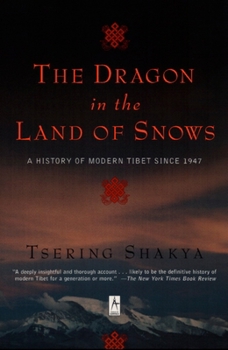The Dragon in the Land of Snows: A History of Modern Tibet Since 1947
Select Format
Select Condition 
Book Overview
Since 1950, Tibet has been sandwiched between the heavyweights of Asian geopolitics: Britain, absolving itself of its colonial dominion; India, finding its legs as a newly independent nation; China,... This description may be from another edition of this product.
Format:Paperback
Language:English
ISBN:0140196153
ISBN13:9780140196153
Release Date:October 2000
Publisher:Penguin Adult Hc/Tr
Length:608 Pages
Weight:1.23 lbs.
Dimensions:1.4" x 5.5" x 8.4"
Age Range:18 years and up
Grade Range:Postsecondary and higher
Customer Reviews
5 ratings
Want to know about Tibet? Read this book
Published by Thriftbooks.com User , 16 years ago
The Tibet issue is totally politicized. Western academics can't get access to Tibet and Tibetan archives unless they kowtow to the Communist authorities in their writing. Then there's the Hollywood types who frequent Dharmasala and do their own version of kowtowing to the sometimes bizarre collection of people surrounding the Dalai Lama. Tsering Shakya's book is an important contribution because it represents fair-minded scholarship at its best. It's an easy read as well.
Objectivity, rare in a book about Tibet
Published by Thriftbooks.com User , 24 years ago
What I noted the most about this book is the fact that the author tries very hard to be objective and impartial in his analysis of the situation in Tibet. Most western books on the topic tend to be blatantly pro-Tibetan independance and are a laundry list of shocking atrocities. I call this the 'Bad China, Good Tibet' view of history. This point of view is non-controversial and highly simplistic in which China is demonized and in which Tibetans are nothing more than clear victims of history. The fact of the matter is, the situation in Tibet is HIGHLY controversial and HIGHLY complex. Simply considering history to be simply 'Bad China, Good Tibet' is a disservice to Tibetans because it fails to give justice to the vicissitudes of their situation. Furthermore, it preempts further inquiry into the full array of historical issues at work and dumbs down the entire dramatic conflict incredibly.This is why I found this book a refreshing look at Tibet's conflict with China. The author tries very hard to remain objective. Instead of using his book to demonize China and list atrocities, he tries to explain Beijing's acts from within the framework of Chinese politics and ideology. This is not to say that he does not give sufficient attention to atrocities, however. The author is also critical of myopic policies of the Tibetan government in handling the 1950 invasion. He also examines India's difficult tightrope walk of trying to have good relations with Beijing while providing humanitarian assistance to the Tibetans. In short, this book tries to be a balanced view of the Chinese occupation of Tibet- This in itself is all-too seldom seen in the west, where we see Brad Pitt (in 7 Years in Tibet) showing us how a nice Nazi mountain-climber introduces the joy of cinema to a rosy-cheeked, perpetually 8-year old Dalai Lama.
an important contribution
Published by Thriftbooks.com User , 24 years ago
Tsering Shakya's book is dispassionate and comprehensive. Instead of simply rehashing and remixing previously published work, it adds to existing accounts by incorporating interviews with first-hand witnesses among the Tibetan exile community (he apparently has not interviewed any Chinese witnesses, which is unfortunate but understandable). Although I have read widely on this subject before, I found much here that's new and not a little that's surprising. I'm sure Tsering Shakya is taking a lot of flack for writing this book. I hope he perseveres, because I believe that the cause of peace is best served by unbiased and unflinching accounts such as this one.
Fine information, awful writing
Published by Thriftbooks.com User , 24 years ago
The thoroughness of this history cannot be doubted. It is a fully detailed history of China's role in modern Tibet. On this point I must agree with all other reviewers. But someone has to point out that this book is horribly written and horribly edited. Names appear with variant spellings-even on the same page. Sentences begin & go no where. Poor writing & editing make this book a difficult read, particularly for non-scholars who may not be fully familiar with names and events. This book does no credit to an important university press in this regard.
Must reading for those interested in Tibet.
Published by Thriftbooks.com User , 25 years ago
This is the first serious attempt to examine the history of Sino-Tibetan relations from 1949 to the present. Before I read it, I had been told that it had upset people on both sides. Now I can see why. It pulls no punches, panders no propaganda, and plays no favorites. Though obviously sympathetic to the plight of the Tibetan people and unsparing in its criticism of Chinese rule, it peels back the layers of myth superimposed by both Chinese and Tibetan exiles to show the mistakes and foolishness on both sides. Shakya's explanation of the recent Panchen Lama imbroglio is clear and accurate. Overall, "must" reading for anyone seriously interested in the Tibet issue and Sino-Tibetan relations.






